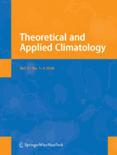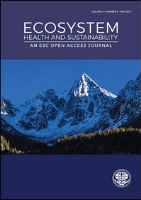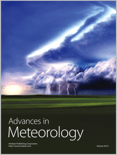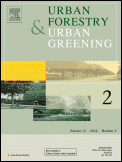
INTERNATIONAL JOURNAL OF BIOMETEOROLOGY
Scope & Guideline
Advancing Knowledge in Climate and Health.
Introduction
Aims and Scopes
- Human Health and Climate Interactions:
Research exploring how climatic variables, such as temperature and humidity, influence human health outcomes, including heat-related illnesses, respiratory diseases, and mental health issues. - Agricultural and Livestock Productivity:
Studies assessing the effects of weather and climate on crop yield, livestock performance, and agricultural practices, including heat stress mitigation strategies and climate adaptability. - Bioclimatic Modeling and Environmental Assessment:
Development and application of models to predict the impacts of climate on biological systems, including phenological changes in plants and animals, and the assessment of urban microclimates. - Climate Change and Ecosystem Responses:
Investigations into how climate change affects biodiversity, ecosystem services, and the resilience of various species to changing environmental conditions. - Thermal Comfort and Outdoor Environments:
Research focused on understanding and improving thermal comfort in outdoor and indoor environments, particularly in the context of urbanization and climate extremes. - Public Health and Policy Implications:
Explorations of how biometeorological research informs public health policies and strategies for managing health risks associated with climate variability.
Trending and Emerging
- Climate Change and Health Impacts:
A growing volume of research is focusing on the direct and indirect health impacts of climate change, particularly how changing weather patterns exacerbate health risks such as heat stress and vector-borne diseases. - Machine Learning Applications in Biometeorology:
The use of machine learning and artificial intelligence in predicting biometeorological phenomena, including crop yield forecasting and health risk assessments, is rapidly increasing, showcasing the integration of technology in traditional biometeorological studies. - Urban Heat Island Effects:
Research on urban heat islands and their impacts on human health, comfort, and energy consumption is gaining traction, reflecting a heightened awareness of urbanization's role in climate dynamics. - Mental Health and Climate Linkages:
Emerging studies are investigating the connections between climate variability, extreme weather events, and mental health outcomes, highlighting the psychological impacts of environmental changes. - Ecosystem Services and Biodiversity Conservation:
Research focusing on the effects of climate change on ecosystem services and biodiversity is becoming more prominent, as the importance of conservation in the face of climate change is increasingly recognized.
Declining or Waning
- Balneotherapy and Spa Treatments:
Research related to traditional balneotherapy and spa treatments has decreased, possibly due to a growing focus on more direct health impacts of climate and weather rather than therapeutic practices. - Historical Climate Analyses:
Studies that focus solely on historical climate data without contemporary relevance or application to current biometeorological issues are becoming less prominent. - General Climate Variability Studies:
Research that does not link climate variability to specific biological or health outcomes is declining, as the journal emphasizes more targeted studies with clear implications. - Traditional Agricultural Practices:
There is a noticeable reduction in papers focusing exclusively on traditional farming methods without integrating modern agricultural science or climate adaptation strategies.
Similar Journals

Inland Waters
Exploring the Depths of Freshwater EcosystemsInland Waters, published by TAYLOR & FRANCIS LTD, stands as a prestigious scholarly journal dedicated to the critical examination of freshwater ecosystems and their management. With an ISSN of 2044-2041 and an E-ISSN of 2044-205X, this journal boasts a remarkable Q1 ranking in both Aquatic Science and Water Science and Technology for 2023, reflecting its significant impact in the field. Researchers and professionals can benefit from its comprehensive coverage of cutting-edge research, methodological advancements, and policy implications concerning inland waters. Committed to disseminating valuable knowledge in a vital area of environmental science, Inland Waters aims to foster collaboration and promote innovative solutions for sustainable water management practices. As it continues through its converged years from 2012 to 2024, the journal remains an essential resource for those dedicated to advancing our understanding and stewardship of freshwater environments worldwide.

THEORETICAL AND APPLIED CLIMATOLOGY
Pioneering Insights for Climate Policy and ResearchTHEORETICAL AND APPLIED CLIMATOLOGY is a prestigious international journal published by Springer Wien, dedicated to advancing knowledge in the field of climatology and atmospheric sciences. With an ISSN of 0177-798X and an E-ISSN of 1434-4483, this journal serves as a vital platform for researchers and professionals to disseminate essential findings and theoretical advancements in climate studies. Notably ranking in the Q2 category of Atmospheric Science with a Scopus rank of #44 out of 148, it holds a significant 70th percentile position in the field, underscoring its reputation and impact within the academic community. An established publication since 1986, it attracts contributions that explore both theoretical frameworks and applied methodologies, enhancing climate-related policymaking and real-world applications. As a non-open access journal, it provides depth and rigor in its peer-reviewed articles, making it an essential read for anyone engaged in climatology research, whether you are a seasoned expert or an emerging scholar eager to contribute to this dynamic field.

Ecosystem Health and Sustainability
Fostering global dialogue on ecosystem resilience.Ecosystem Health and Sustainability, published by the American Association for the Advancement of Science, is a premier journal in the field of ecological research and sustainability. Established as an Open Access journal since 2015, it has made significant strides in disseminating impactful research that addresses contemporary challenges in ecosystem health within a global context. With an impressive impact factor reflected in its consistent placement in the Q1 category across multiple fields—including Ecology, Evolution, Behavior and Systematics, as well as Management, Monitoring, Policy, and Law—this journal serves as a vital resource for researchers, professionals, and students alike. Based in the United Kingdom, the journal has shown notable performance in Scopus rankings, positioning itself within the top percentiles across various ecological specialties. As it continues its convergence through 2024, Ecosystem Health and Sustainability is committed to fostering the exchange of knowledge and promoting the integration of science and policy to advance sustainable practices globally.

Advances in Meteorology
Championing Open Access in Meteorological StudiesAdvances in Meteorology is a renowned open-access journal published by Hindawi Ltd, dedicated to the dynamic field of meteorology and related atmospheric sciences. Since its inception in 2009, this journal has served as a vital platform for researchers and professionals, facilitating the dissemination of cutting-edge research that advances our understanding of atmospheric phenomena. With a commendable impact in the realms of Geophysics, Atmospheric Science, and Environmental Pollution, it boasts impressive Scopus rankings—34th percentile in Geophysics, 54th in Atmospheric Science, and 61st in Environmental Pollution—highlighting its significance and relevance in these critical areas. The journal's commitment to open access ensures that vital research reaches a wide audience, fostering collaboration and innovation within the scientific community. Positioned with a mix of rigorous research and interdisciplinary approaches, Advances in Meteorology continues to shape the landscape of atmospheric science research from its base in Egypt, addressing pressing global challenges related to climate and environment.

FOREST SCIENCE
Advancing knowledge in forestry and ecology.FOREST SCIENCE, published by Oxford University Press Inc, is a pivotal journal in the field of forestry and ecological modeling, boasting an impressive track record since its inception in 1970. With an ISSN of 0015-749X and E-ISSN 1938-3738, the journal provides a valuable platform for the dissemination of high-quality research and studies that address contemporary challenges in forestry and ecology. It ranks in the Q2 category for both ecology and forestry and holds a Q3 ranking in ecological modeling according to the latest evaluations, illustrating its significant contribution to these fields. The journal is accessible through various options, facilitating broad readership and engagement within the academic community. As part of its commitment to advancing knowledge and practices in forest management and conservation, FOREST SCIENCE seeks to bridge theoretical research with practical applications, making it an indispensable resource for researchers, professionals, and students alike.

Earth Systems and Environment
Advancing Knowledge for a Sustainable FutureEarth Systems and Environment, published by Springer International Publishing AG, is a leading peer-reviewed journal dedicated to the multidisciplinary study of natural and anthropogenic processes that shape the Earth's systems. With an impressive impact factor and consistently ranked in the Q1 category across various fields, including Computers in Earth Sciences, Economic Geology, and Environmental Science, it stands as a premier platform for researchers and professionals seeking to address pressing environmental challenges. The journal covers a wide spectrum of topics, from geology to global change, and emphasizes innovative methodologies and interdisciplinary approaches to understand and manage Earth systems. As an essential resource for scholars and practitioners, Earth Systems and Environment commits to excellence and facilitates open dialogue on critical issues affecting our planet.

BULLETIN OF THE AMERICAN METEOROLOGICAL SOCIETY
Exploring the dynamics of our atmosphere, one study at a time.BULLETIN OF THE AMERICAN METEOROLOGICAL SOCIETY, published by the American Meteorological Society, stands as a premier forum in the field of meteorology and atmospheric science, boasting an impressive ranking in the Q1 category for 2023. With a long-standing history dating back to 1972, this journal serves as a vital resource for researchers, practitioners, and students dedicated to advancing the understanding of atmospheric phenomena. The journal facilitates the dissemination of cutting-edge research, innovative methodologies, and significant findings that propel the scientific community forward. Although not an Open Access journal, it remains a critical publication for comprehending complex environmental interactions, climate change, and weather-related phenomena. The BULLETIN OF THE AMERICAN METEOROLOGICAL SOCIETY is essential reading for anyone invested in atmospheric sciences, providing invaluable insights that shape policy, enhance safety, and promote environmental sustainability.

Idojaras
Elevating the discourse in weather and climate studies.Idojaras, a prominent journal published by the Hungarian Meteorological Service, has been a vital contributor to the field of Atmospheric Science since its inception in 1980. With a specific focus on the intricacies of weather phenomena, climate variability, and environmental change, this journal serves as a platform for researchers and professionals to disseminate their findings. Although currently categorized in Q4 of Atmospheric Science with a Scopus rank of #122 out of 148, Idojaras is dedicated to improving its impact and visibility through rigorous peer-reviewed research and comprehensive analyses that engage a global audience. This scholarly publication, which operates without open access, is pivotal for advancing knowledge in meteorological studies, thereby appealing not only to seasoned scientists but also to students and scholars eager to explore this dynamic field. Located in Budapest, Hungary, the journal continues to strive for excellence in its coverage through the convergence of past and present meteorological research, making it a significant resource for anyone interested in the atmospheric sciences.

URBAN FORESTRY & URBAN GREENING
Elevating urban landscapes with cutting-edge forestry practices.URBAN FORESTRY & URBAN GREENING is a premier interdisciplinary journal published by Elsevier GmbH, dedicated to advancing the fields of urban forestry and sustainable greening practices. With an impressive impact factor and consistently ranked in Q1 across ecology, forestry, and soil science disciplines, this journal offers valuable insights into the vital roles of urban vegetation in enhancing environmental quality and biodiversity. Since its inception in 2002, it has served as a crucial platform for innovative research, showcasing studies that address the challenges and opportunities of integrating green spaces within urban landscapes. The journal's commitment to publishing high-quality articles ensures that researchers, professionals, and students stay at the forefront of the latest scientific developments, reinforcing its significance in shaping urban environmental policy and practice. For those seeking to contribute to this vibrant field, URBAN FORESTRY & URBAN GREENING remains a vital resource for sharing knowledge and fostering collaboration among experts.

Contemporary Problems of Ecology
Advancing the Dialogue on Ecological ChallengesContemporary Problems of Ecology, published by MAIK NAUKA/INTERPERIODICA/SPRINGER, is a premier journal committed to advancing research in the field of Environmental Science. Since its inception in 2008, this journal has carved a niche for itself in addressing the pressing ecological challenges of our times, catering to an audience comprising researchers, professionals, and students dedicated to the sustainability and environmental health of our planet. The journal is indexed in Scopus, with a current ranking of #165 out of 233 in the Environmental Science category, reflecting its contributions to the academic community, despite its position in the 29th percentile. With the latest quartile ranking placing it in Q3 for miscellaneous Environmental Science from 2023, the journal continues to be a vital resource for disseminating innovative research findings. Contemporary Problems of Ecology promotes open access scholarship and aims to foster a dialogue among experts, making it an essential platform for those looking to engage with contemporary ecological issues and solutions. The journal actively seeks to publish original research articles, reviews, and case studies that push the boundaries of our understanding of environmental systems.